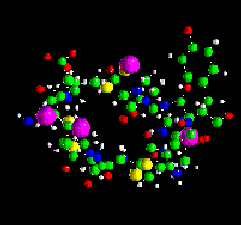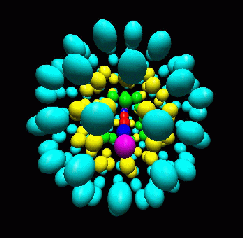Optimization Algorithms for
Macromolecular Modeling
 Global optimization techniques are central to the solution of
macromolecular modeling and simulation problems,
The aim of this project is to develop a high-performance environment
for the
Center for Computational Science and Technology
at Argonne that supports large scale global
optimization.
We have done work on the determination of protein
structures, ionic systems and molecular clusters.
Current work focuses on distance geometry optimization
for protein structures.
Global optimization techniques are central to the solution of
macromolecular modeling and simulation problems,
The aim of this project is to develop a high-performance environment
for the
Center for Computational Science and Technology
at Argonne that supports large scale global
optimization.
We have done work on the determination of protein
structures, ionic systems and molecular clusters.
Current work focuses on distance geometry optimization
for protein structures.
Gaussian Smoothing
An appealing idea for finding the global minimizer of
a function is to transform the function
into a smoother function with fewer local minimizers,
apply an optimization algorithm to the transformed function,
and trace the minimizers back to the original function.
A transformed function
is a coarse approximation to the original function,
with small and narrow minimizers being removed
while the overall structure of the function is maintained.
This property allows a local minimization procedure
to skip less interesting local minimizers
and to concentrate on regions with low function values,
where a global minimizer is most likely to be located.
The smoothing transform, called the Gaussian transform,
depends on a parameter that controls the degree of smoothing.
The original function is obtained if the parameter is zero,
while smoother functions are obtained as the parameter increases.
Further information on Gaussian smoothing
can be found in the following papers:
- Jorge Mor� and Zhijun Wu, Distance geometry optimization for protein
structures, Journal on Global Optimization, 15 (1999), pp. 219-234.
- Jorge Mor� and Zhijun Wu, Epsilon-optimal solutions to distance
geometry problems via global continuation, in Global Minimization of
Nonconvex Energy Functions: Molecular Conformation and Protein Folding, P. M.
Pardalos, D. Shalloway, and G. Xue, eds., pages 151-168, American Mathematical
Society, 1996.
- Jorge Moré and Zhijun Wu, Issues in large-scale global molecular
optimization, in Large Scale Optimization with Applications: Molecular Structure
and Optimization, Lorenz T. Biegler, Thomas F. Coleman, Andrew R. Conn and
Fadil N. Santosa, eds., IMA Volumes in Applied Mathematics and Applications 94,
pages 99-122, Springer-Verlag, 1997.
- Jorge Moré and Zhijun Wu, Smoothing techniques for macromolecular global
optimization, in Nonlinear Optimization and Applications, G. Di Pillo and
F. Giannessi, eds., pages 297-312, Plenum Press, 1996.
- Jorge Moré and Zhijun Wu, Global continuation for distance geometry problems,
SIAM J. Optim. 7, no. 3 (August 1997), pp. 814-836.

Macromolecular Conformation
We have developed
DGSOL,
a software package for
for the solution of distance geometry problems
with lower and upper bounds on the distance data.
These problems arise in the interpretation of NMR data
and in the determination of protein structures.
DGSOL has been developed for both sequential and
parallel architectures.
Solutions have been obtained
for a set of model problems with up to 1500 variables, with
excellent performance on the IBM SP.
We have also used the algorithms
to determine the structure of protein fragments,
such as the the active fragment of E. Coli STh enterotoxin shown here,
or the DNA-binding protein shown above.

Configurations of Ionic Systems
We have also developed algorithms for finding stable
configurations of ionic systems.
The stable configuration for an ionic system
can be found by minimizing the energy function for the system
over configuration space.
Stable configurations for a set of small systems
have been obtained by using Gaussian smoothing algorithms on the IBM Quad.
We are now working on larger ionic systems.
An important goal of this work is to find the stable configurations
for very large systems, say, systems of 200,000 ions.
The optimal structure with 200 ions is shown here.
This work is joint with John Schiffer and Steve Pieper
of Argonne's Physics division.
Argonne National Laboratory / [email protected]

 Global optimization techniques are central to the solution of
macromolecular modeling and simulation problems,
The aim of this project is to develop a high-performance environment
for the
Center for Computational Science and Technology
at Argonne that supports large scale global
optimization.
We have done work on the determination of protein
structures, ionic systems and molecular clusters.
Current work focuses on distance geometry optimization
for protein structures.
Global optimization techniques are central to the solution of
macromolecular modeling and simulation problems,
The aim of this project is to develop a high-performance environment
for the
Center for Computational Science and Technology
at Argonne that supports large scale global
optimization.
We have done work on the determination of protein
structures, ionic systems and molecular clusters.
Current work focuses on distance geometry optimization
for protein structures.

